|
December 1999
My friend, Larry, and I had driven this
very same road earlier, when the sun played over the rock-strewn dirt.
Now, in the dark, 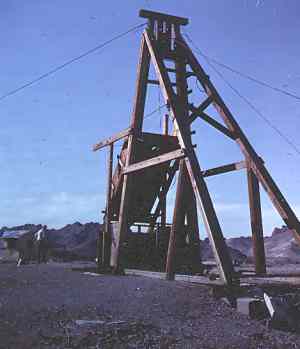 we
were rolling along in our home-built dune buggy scanning the widening
wash cluttered with smoke-trees and other confusing vegetation, keeping
our eyes searching for the side wash that would take us into the "Silver
District" and the Red Cloud mine. The year is 1963. The state is
Arizona. We were a long way from our primitive camp near Martinez Lake,
on the Colorado River. we
were rolling along in our home-built dune buggy scanning the widening
wash cluttered with smoke-trees and other confusing vegetation, keeping
our eyes searching for the side wash that would take us into the "Silver
District" and the Red Cloud mine. The year is 1963. The state is
Arizona. We were a long way from our primitive camp near Martinez Lake,
on the Colorado River.
At last the dune buggy's headlights
lit the side canyon we wanted, and with a distinctive roar, from the rear-mounted
Volkswagon engine we bounced over the ruts and rocks and into the final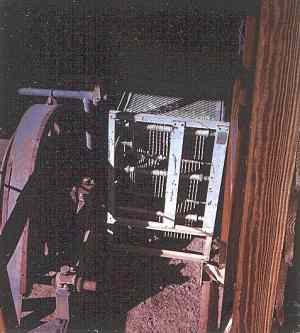 low canyon that would carry us past ghostly piles of rubble left over
from long-vanished mines. Names like the Black Rock, the Pacific, the
Red Cloud, and beyond that, for another day, the Clip mine.
low canyon that would carry us past ghostly piles of rubble left over
from long-vanished mines. Names like the Black Rock, the Pacific, the
Red Cloud, and beyond that, for another day, the Clip mine.
The road now opened out into the large
area occupied by the Red Cloud buildings, and 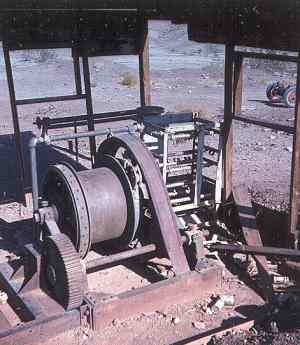 scattered
equipment used at one time, now tossed aside. A flotation mill, used to
float off the lesser minerals and collect the heavier silver values deeper
within it. A vibratory table to separated the fine crushed ore from it's
companion minerals. Even a very large air compressor was still in place,
though damaged beyond repair by powerfull bullets. In this year of 1963,
much remained of the wooden buildings housing an office, assay lab, the
hoist's electric motor, controller, and drum of wire rope disappearing
down into the open mine shaft. Silver chlorides scattered
equipment used at one time, now tossed aside. A flotation mill, used to
float off the lesser minerals and collect the heavier silver values deeper
within it. A vibratory table to separated the fine crushed ore from it's
companion minerals. Even a very large air compressor was still in place,
though damaged beyond repair by powerfull bullets. In this year of 1963,
much remained of the wooden buildings housing an office, assay lab, the
hoist's electric motor, controller, and drum of wire rope disappearing
down into the open mine shaft. Silver chlorides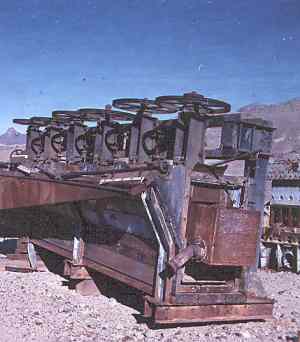 were the dominant ore, though the Red Cloud ran into some pure silver
at the 150' level. Various methods of recovering the silver from the ore
in the early days was grinding the ore to powder, mixing it with hot salt
brine and mercury to amalgamate it, finally roasting the mercury from
the silver. A newer method tried in Europe, treated the powdered ore with
cyanide.
were the dominant ore, though the Red Cloud ran into some pure silver
at the 150' level. Various methods of recovering the silver from the ore
in the early days was grinding the ore to powder, mixing it with hot salt
brine and mercury to amalgamate it, finally roasting the mercury from
the silver. A newer method tried in Europe, treated the powdered ore with
cyanide.
But tonight we were not going to be
mining, I had brought my ancient short-wave 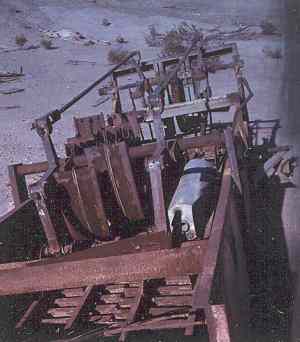 ultraviolet
light with me. Without the "black light:", it was impossible
to pick fluorescent calcite from the non-fluorescent calcite. When the
short wave "black light" struck the calcite, it caused the mineral
to glow a very bright red. We were not the only mineral collectors here
tonight. A man and his young son were carefully prying the beautiful orange
tabular crystals of wulfenite from the same dirt embankment we used. ultraviolet
light with me. Without the "black light:", it was impossible
to pick fluorescent calcite from the non-fluorescent calcite. When the
short wave "black light" struck the calcite, it caused the mineral
to glow a very bright red. We were not the only mineral collectors here
tonight. A man and his young son were carefully prying the beautiful orange
tabular crystals of wulfenite from the same dirt embankment we used.
After oohing and aahing at the crystals
of wulfenite, we gathered our small canvas bags of fluorescent calcite,
took a final look around at the star-lit surroundings, belted ourselves
into our dune buggy and started the long, but pleasant, ride back to our
primitive camp near Martinez Lake. I hope you enjoyed the trip. -- Jerome
W. Anderson
|

